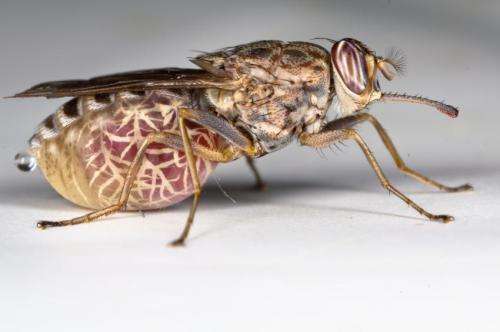Innovative approach could ultimately end deadly disease of sleeping sickness

A tag team of two bacteria, one of them genetically modified, has a good chance to reduce or even eliminate the deadly disease African trypanosomiasis, or sleeping sickness, researchers at Oregon State University conclude in a recent mathematical modeling study.
African trypanosomiasis, caused by a parasite carried by the tsetse fly, infects 30,000 people in sub-Saharan Africa each year and is almost always fatal without treatment. In a 2008 epidemic, 48,000 people died.
In this research, scientists evaluated the potential for success of a new approach to combat the disease – creating a genetically modified version of the Sodalis bacteria commonly found in the gut of the flies that carry the disease, and using different bacteria called Wolbachia to drive the GMO version of Sodalis into fly populations.
When that's done, the GMO version of Sodalis would kill the disease-causing trypanosome parasite. According to the analysis published in PLOS Neglected Tropical Diseases, researchers say this should work – and could offer a model system for other tropical, insect-carried diseases of even greater importance, including dengue fever and malaria.
"There are a few 'ifs' necessary for this to succeed, but none of them look like an obstacle that could not be overcome," said Jan Medlock, an assistant professor in the OSU Department of Biomedical Sciences, and lead author on the new report.
"If everything goes right, and we are optimistic that it will, this could be enormously important," Medlock said. "There's a potential here to completely solve this disease that has killed many thousands of people, and open new approaches to dealing with even more serious diseases such as malaria."
Some of the "ifs" include: the transgenic Sodalis has to be reasonably effective at blocking the parasite, at or above a level of about 85 percent; the Wolbachia bacteria, which has some effect on the health of flies affected with it, must not kill too many of them; and the target species of fly has to be a majority of the tsetse flies in the areas being treated.
The research shows that dealing with all of those obstacles should be possible. If so, this might spell the end of a tropical disease that has plagued humans for hundreds, possibly thousands of years. African trypanosomiasis causes serious mental and physical deterioration – including the altered sleep patterns that give the disease its name – and is fatal without treatment. It's still difficult to treat, and neurologic damage is permanent.
Past efforts to control the disease, including insect traps, insecticide spraying, and use of sterile insects have been of some value, but only in limited areas and the effects were not permanent.
The strength of the new approach, researchers say, is that once the process begins it should spread and be self-sustaining - it should not be necessary to repeatedly take action in the huge geographic areas of Africa. Due to some genetic manipulation, the flies carrying the Wolbachia bacteria should naturally increase their populations and have an inherent survival advantage over conventional tsetse flies.
As the flies carrying transgenic bacteria continue to dominate and their populations spread, trypanosomiasis should fairly rapidly disappear. Whether the mechanism of control could wane in effectiveness over time is an issue that requires further study, scientists said.
Work has begun on the GMO version of Sodalis that has the capability to resist trypanosomes . It's not yet finalized, Medlock said, but it should be possible, and when complete, the bacteria will be very specific to tsetse flies.
Medlock, an expert in modeling the transmission of various diseases – including human influenza – says the analysis is clear that this approach has significant promise of success. Because of the relatively low infectiousness of the parasite and the ability of Wolbachia to drive the resistance genes, no part of the system has to be 100 percent perfect in order to ultimately achieve near eradication of this disease, he said.
Accomplishing a similar goal with diseases such as malaria may be more difficult, he said, because that disease historically has shown a remarkable ability to mutate and overcome many of the approaches used to attack it. However, at least some near-term gains may be possible, he said.
More information: www.plosntds.org/article/info:doi%2F10.1371%2Fjournal.pntd.0002374
















